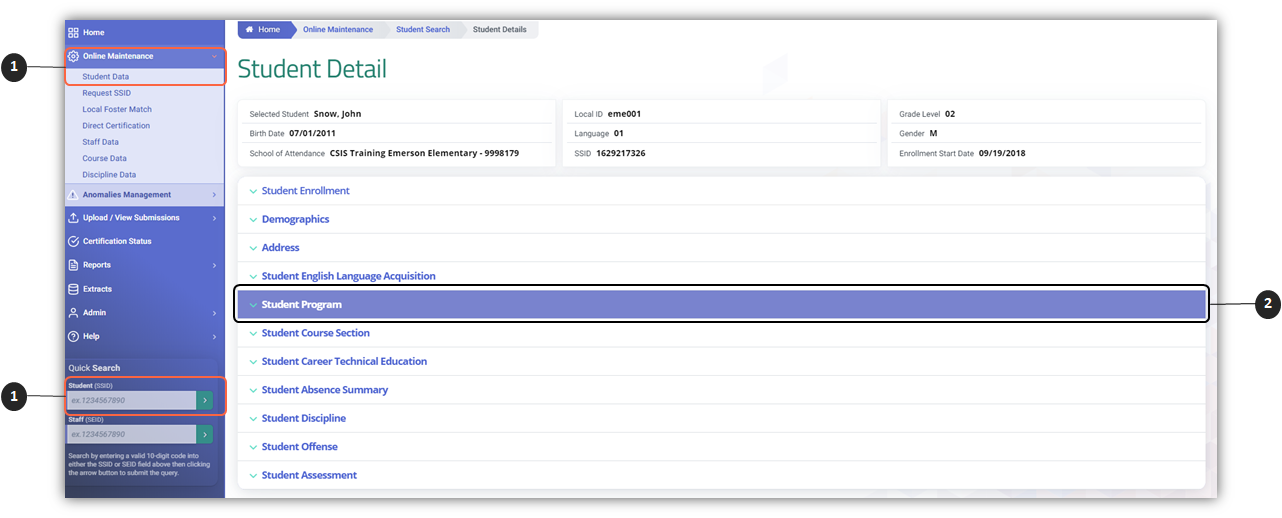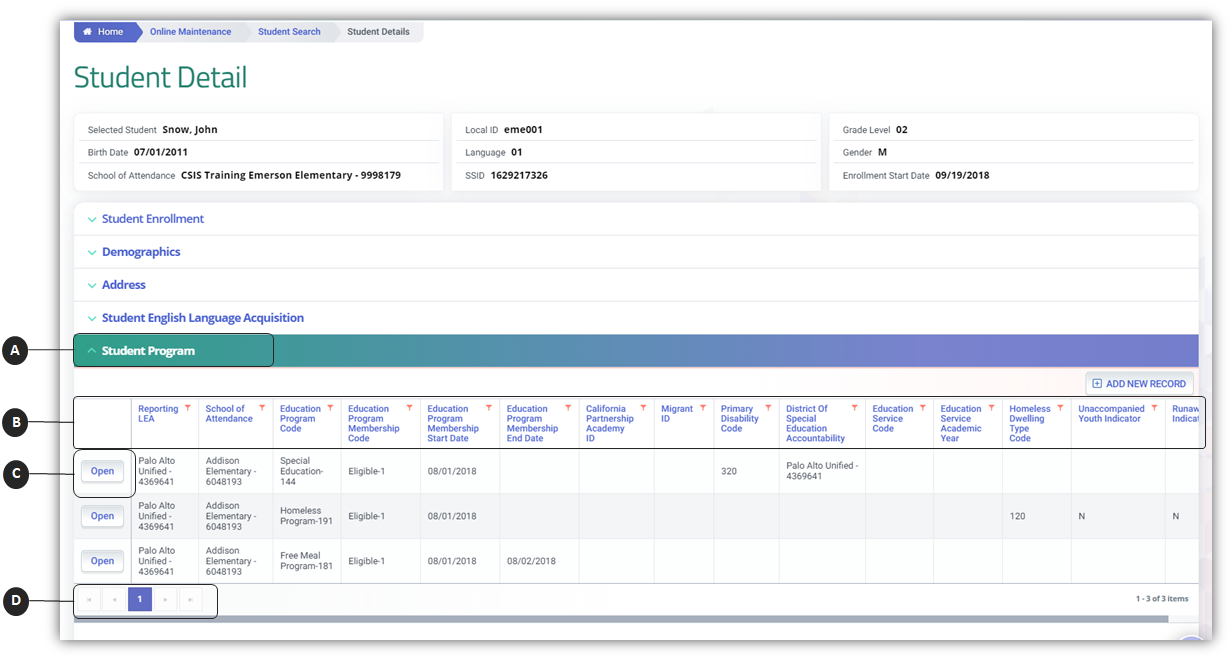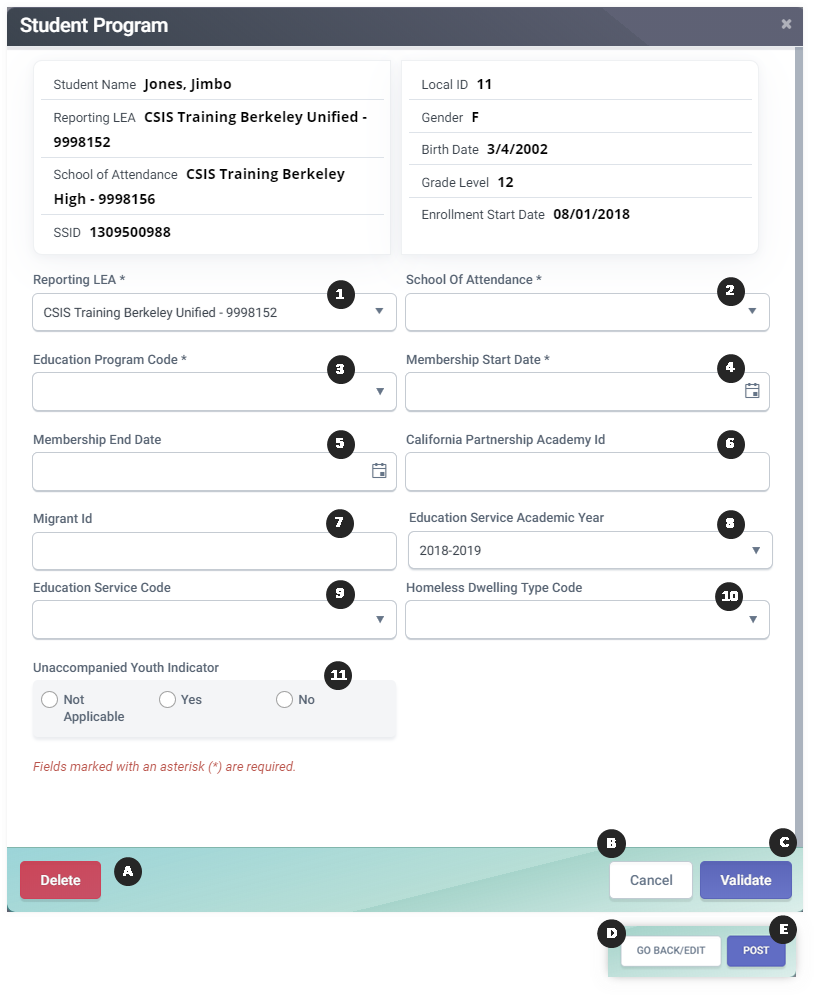Student Program (SPRG)
(Updated as of 9/20/2024)
The Student Program container appears on the Student Details page. The page opens with the Student Program container in the collapsed position. Clicking the down arrow on the containers displays the individual program records for the selected student. The system will display all Program records by default, but only will allow editing of Program records belonging to the user’s LEA. The selected student’s historical records will be displayed in reverse chronological order. NOTE: If a user is not authorized to add, edit, or view confidential data types, some student program records will not be displayed.
Account Roles Needed for SPRG
Users need the following roles to access this section of the Student Details page.
- Student Search
- SPRG Edit
- SPRG View
- Free and Reduced Price Meal EDIT
- Free and Reduced Price Meal VIEW
An authorized user may perform the following functions through this interface:
- View one or all of a student’s Program records belonging to the user's LEA or another LEA (depending on the user permissions)
- Modify existing Program records owned by the LEA the user is associated to.
- Add new Program record(s).
- Add/Modify the displayed existing Free and Reduced Lunch program records
Navigating to the SPRG User Interface
A user first searches the student either through the SSID or demographic search process ![]() to get to the Student Details page. By default, the Student Program container will be in the collapsed position. Clicking the container header
to get to the Student Details page. By default, the Student Program container will be in the collapsed position. Clicking the container header ![]() displays the individual program records for the selected student.
Refer to Searching for Students
displays the individual program records for the selected student.
Refer to Searching for Students

Student Detail Program Container
The Student Program UI is depicted below followed by its screen elements table and the “Program” UI depiction by its screen elements table. Following the two depictions are the user interaction section and the system operations section with the available system functions, requirements and possible processes that may occur through these interfaces.

![]() Clicking on the Student Program header expands the container and reveals existing records.
Clicking on the Student Program header expands the container and reveals existing records.
![]() Container column headers enable users to sort or filter existing incident records based on parameters set.
Container column headers enable users to sort or filter existing incident records based on parameters set.
![]() Open button enable users to view details of the student program record. Record can only be modified if the record is owned by the LEA the user is associated to.
Open button enable users to view details of the student program record. Record can only be modified if the record is owned by the LEA the user is associated to.
![]() Since the container only shows limited records at a time, the page buttons allow users to move to the next set of records.
Since the container only shows limited records at a time, the page buttons allow users to move to the next set of records.
If a user is authorized to add and edit records, the user will be able to click on the Open button of each record listed as well as the Add a New Record button.
If a user clicks either button the system will display the “Program” page with the respective fields populated with either values from the student’s existing record or the specified system default values. If the user attempts to navigate from the page before completing the process, the system will display a warning message for the user to confirm the update/addition data will not be submitted to the ODS.
Student Program Modal
The Student Program Details modal is depicted below followed by a screen elements table. If the user clicks to open an existing record, the Student Programs page appears with the values from the student’s selected record. If the Add a New Record button is clicked, all fields on the page will be populated with Null values when the page opens. LEA-level users will be able to modify the School of Attendance, but School-level users will not. All other input will conform to the Screen Elements described below.

Student Program Elements Table
| # | Field | Required | Validation/Business Rule |
|---|---|---|---|
| 1 | Reporting LEA | Y | Default to user’s current Org; only present values related to user’s Org. Field must meet the defined CALPADS’ data validation and processing requirements. |
| 2 | School of Attendance | Y | The 7-digit School (S) code must be submitted. |
| If the entity is an independently reporting charter school, the School (S) code must be submitted for both the School of Attendance and the Reporting LEA. | |||
| If student attends an NPS school, the School of Attendance is identified as 0000001. The NPS School is identified in the element "School of Attendance NPS" | |||
| 3 | Education Program Code | Y | If the user does not have authorization to add/edit confidential data types, some program codes will not be accessible. Field must meet the defined CALPADS’ data validation and processing requirements. Note: If codes are retired they will not be removed as a value via the dropdown as they need to exist for prior year submissions and reports. The effective end date in the code set will prevent future data from being submitted through an input validation. |
| 4 | Membership Start Date | Y | Field must meet the defined CALPADS’ data validation and processing requirements. See Data Guide Chapter 2.1.3 Start and end dates for program eligibility |
| 5 | Membership End Date | N | Field must meet the defined CALPADS’ data validation and processing requirements. See Data Guide Chapter 2.1.3 Start and End dates for program eligibility |
| 6 | California Partnership Academy ID | Required If Education Program Code = 113 (California Partnership Academy) | Must be a valid identifier on the CDE California Partnership Academy list |
| 7 | Migrant ID | Required If Education Program Code = 135 (Migrant) | This is the state Migrant Student Directory (MSD) number as assigned in the Migrant Student Information Network (MSIN) data system. This is NOT the identifier used in the COE Star system, which is alphanumeric. The Migrant Student ID must be exactly 11 characters with the first two characters beginning with "06" |
| 8 | Education Service Academic Year | Required if Education Program Code = 122 (NCLB Title 1 Part A Basic Targeted) | Field must meet the defined CALPADS’ data validation and processing requirements. |
| 9 | Education Service Code | Required if Education Program Code = 122 (NCLB Title 1 Part A Basic Targeted) | Field must meet the defined CALPADS’ data validation and processing requirements. |
| 10 | Homeless Dwelling Type Code | Required If Education Program = 191 (Homeless Program) | Homeless Dwelling Type Code |
| 11 | Unaccompanied Youth Indicator | Required If Education Program Code = 191 (Homeless Program) | An indication of whether or not a student who has been identified as homeless is not in the direct care of their parent or guardian. |
| Action Buttons | |||
| A | Delete Record | N/A | If clicked, the system will delete the student’s program record from the ODS when the user confirms the deletion. “Are you sure you want to delete this record? Yes/No” |
| B | Cancel | N/A | If clicked, the modal will close and the system will display the Program Container page. |
| C | Validate | N/A | Validation is a two-stage process – Stage 1 performs client-side validations on missing data in required fields and data type errors. Stage 2 performs validation checks on Student Programs IVRs. If no fatal errors detected on IVRs for Student Programs but Warning IVRs are triggered, then “Validation Successful and warnings exist”, followed by a list of warning IVRs. |
| If no fatal errors are detected on IVRs for Student Programs, two new buttons, Post and Cancel are presented. | |||
| D | Go Back/Edit | N/A | Appears after validation if no fatal errors are detected. If selected, system will return fields to editable, retaining any values that have already been changed from original record. |
| E | Post | N | If no fatal validation errors, this option will be presented. If the user clicks the button, system will post records. If not successful, “Post failed” with accompanying error message. |
Student Program Data Collected
Student program eligibility and participation must be reported to CALPADS as soon as the information is available and continuiously maintained throughout the academic year.
If a student to another school within a district and still meets eligibility or is participating in the same programs, a new program record must be report for the student at the new school.
The following are the expected student programs collected in the different submissions.
Fall 1 Programs Collected
|
Code |
Program |
Type |
|
181 |
Free Meal Program |
Federal |
|
182 |
Reduced-Priced Meal Program |
Federal |
|
127 |
Gifted and Talented Education (GATE) |
Federal |
|
135 |
Title I Part C Migrant |
State |
|
185 |
Transitional Kindergarten |
State |
|
191 |
Homeless Program |
Federal |
|
193 |
Tribal Foster Youth |
State |
|
300 |
LIP - Developmental Bilingual Program (For EL students only) |
State |
|
301 |
LIP - Dual-Language Immersion Program |
State |
|
302 |
LIP - Heritage or Indigenous Language |
State |
|
303 |
LIP - Newcomer Program (Various Models) (For EL students only) |
State |
|
304 |
LIP - One-Way Immersion Program |
State |
|
305 |
LIP - Structured English Immersion Program or other predominantly English Language Instructional Models (For EL students only) |
State |
|
306 |
LIP - Transitional Bilingual Program |
State |
|
307 |
LIP - Parent Opted Out of EL Services (For EL students only) |
State |
End of Year Programs Collected
|
Code |
Program |
Type |
|
122 |
Title I Part A Basic Targeted |
Federal |
|
174 |
Title I Part A Neglected |
Federal |
|
191 |
Homeless Program |
Federal |
|
192 |
Armed Forces Family Member |
Federal |
|
101 |
504 Accommodation Plan |
State |
|
108 |
Opportunity Program |
State |
|
113 |
California Partnership Academy |
State |
|
162 |
Pregnant or Parenting Programs (formerly Cal-SAFE) |
State |
|
185 |
Transitional Kindergarten |
State |
NSLP Reporting Nuances
Here are some guidance LEAs must be aware of when reporting student NSLP eligibility.
|
Nuance |
Local Lunches and/or Nutrition system |
CALPADS |
Possible Action |
|
Prior year eligibility that carries over to the first 30 days of new academic year pending new eligibility |
Entered and tracked in lunch program system |
NEVER report in CALPADS |
Do not submit a SPRG record to CP until eligibility is established for Academic Year |
|
Applications received by 10/31 & student found eligible prior to or after 10/31 |
Entered and tracked in lunch program system |
Report eligibility by submitting a Program 181/182 record FRPM eligible Results Reported on 1.17 for LCFF |
Use Start date equal or prior to 10/31 |
|
Applications received after 10/31 and student found eligible after 10/31 |
Entered and tracked in lunch program system |
Report eligibility by submitting a Program 181/182 record using the true eligibility date NOT reported on 1.17 for LCFF (even if student enrolled on Census day) |
Use start date equal to date application was received |
|
Provision 2 and 3 or CEP Schools (Note: Base year requires collection from all students; succeeding years collection will only be from new students) |
Entered and tracked in lunch program system
|
Report eligibility by submitting a Program 181 record FRPM eligible Reported on 1.17 for LCFF |
Do not submit a SPRG record until eligibility is established for Academic Year |
LIP Program Start and End Dates
Below are guidance on what program membership dates to use for LIP records.
- Students participating prior to the current academic year, use the date the student became eligible for and began participating in the program, or if that is not known, use the first day of school in the current academic year.
- For students who are newly identified as English learners (EL) in the current academic year, use their English Language Acquisition Status (ELAS) Start Date.
- For non-English learners who began participating in these programs in the current year, use their enrollment start date for the academic year.
- LEAs should not annually close SPRG language instruction program records at the end of the school year if returning students will continue in the same program the following school year. For students exiting the school, these records may, but are not required to be closed.
-
Students transferring school within the LEA mus have a new LIP record reported at the new school.
-
Students who are reclassified to RFEP must exit existing LIP programs (300, 303, 305, 307) with a date that is before the RFEP status date, even if they are still participating in the program.
-
Adult EL students (ADEL) must exit existing open LIP programs (300, 303, 305, 307) with a date that is before the ADEL status date even if they are still participating in the program.
Language Instructional Program Mapping
|
New Education Program Code |
Name of New Education Program Code |
Retired Instructional Strategy Code |
Name of Retired Instructional Strategy Code |
|
300 |
LIP – Developmental Bilingual Program |
600 |
English Learner Bilingual Program |
|
301 |
LIP – Dual-Language Immersion Program |
400 |
Dual Language Immersion Program |
|
302 |
LIP – Heritage or Indigenous Language |
none |
n/a |
|
303 |
LIP – Newcomer Program (various models) |
none |
n/a |
|
305 |
LIP – Structured English Immersion Program or other predominantly English Language Instructional Models |
500 Or 650 |
Structured English Immersion/Other English Model English Learner Mainstreaming |
|
306 |
LIP – Transitional Bilingual Program |
600 |
English Learner Bilingual Program |
Language Instructional Program Codes
|
Code |
Program Name |
Description |
|
300 |
LIP - Developmental Bilingual Program (For EL students only) |
A language instructional program (LIP) designed for English learners which provides content instruction delivered in the students’ native language and English. |
|
301 |
LIP - Dual-Language Immersion Program |
A language instructional program (LIP) designed for English learners and native English speakers, which provides content instruction delivered in the English learners’ native language and English. Program models may include Two-Way Immersion, 50/50 Dual Immersion, 90/10 Dual Immersion, and other similar program models. |
|
302 |
LIP - Heritage or Indigenous Language |
A language instructional program (LIP) in English and another language for non-English speakers or students with limited literacy skills in their first language. Indigenous language programs support endangered minority languages in which students may have limited receptive and no productive skills. Both programs often serve American Indian students |
|
303 |
LIP - Newcomer Program (Various Models) (For EL students only) |
A language instructional program (LIP) designed for English learners who are new to the country with less than 12 months of schooling in the United States. This program provides instruction in designated and integrated English language development (ELD) based on the state-adopted CA ELD |
|
304 |
LIP - One-Way Immersion Program |
A language instructional program in English and another language for non-speakers of the other language, with the goals of language proficiency and academic achievement in English and the other language, and cross-cultural understanding. The portion of the instructional day delivered in each language varies by the type of program. |
|
305 |
LIP - Structured English Immersion Program or other predominantly English Language Instructional Models (For EL students only) |
A language instructional program (LIP) designed for English learners in which nearly all classroom instruction is provided in English with curriculum and a presentation designed for students who are learning English. The goals of this program are language proficiency and academic achievement in English. Students receive instruction in designated and integrated English language development (ELD) based on the state-adopted CA ELD standards |
|
306 |
LIP - Transitional Bilingual Program |
A language instructional program (LIP) designed for English learners utilizing English and students’ native language for literacy and academic instruction, with the goals of language proficiency and academic achievement in English |
|
307 |
LIP - Parent Opted Out of EL Program (For EL students only) |
The local educational agency (LEA) is not providing any instructional services designed for English learners because the parent of this English learner has opted this student out of EL services. The LEA maintains a record of the action to demonstrate the parents have chosen to opt out of such services. |
SPRG Data Population Training
Additional References
CALPADS Error List
Look for Student Programs Tab
CALPADS File Specifications
Look for Student Programs Tab
CALPADS Data Guide
Chapter 2.2.2 provides additional information on Job classifications.